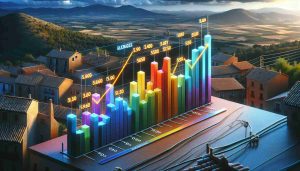Stock markets around the world experienced mixed reactions to economic uncertainty on Friday. While some indices opened slightly higher following two consecutive sessions of gains, others struggled to maintain momentum. In Asia, the Nikkei 225 in Tokyo stood out with a 0.4% increase, contrasting the overall downturn influenced by concerns over Federal Reserve decisions.
Commodity markets reflected a similar volatile sentiment as oil prices remained relatively stable but poised for a weekly decline. While downward revisions in US employment data raised demand worries, ceasefire talks in Gaza alleviated supply concerns. The Brent crude in Europe saw a modest 0.14% rise, while West Texas futures increased by 0.18%.
Foreign exchange markets saw the euro making gains against the dollar amidst anticipation for Jerome Powell’s speech. The euro rose by 0.14% to reach a rate of 1.1126 dollars. This positive movement hinted at investor caution amidst ongoing currency fluctuations.
Meanwhile, the outlook for the United States Treasury bond market remained uncertain as global investors awaited signals on potential shifts in monetary policy. The yield on the benchmark ten-year US bond decreased to 3.842%, reflecting market apprehension towards future interest rate adjustments.
Overall, the day was marked by a sense of anticipation and caution among investors worldwide as they closely monitored economic indicators and central bank announcements for insights into market direction. The dynamic interplay of global financial markets underscores the interconnected nature of today’s economic landscape.
Global Markets Navigate Uncertainty Amidst Economic Challenges
The global markets continue to navigate through uncertainty in the face of ongoing economic challenges, with various factors influencing investment decisions and market movements. As investors grapple with ever-changing conditions, new questions and complexities arise in understanding the implications of economic uncertainty on a global scale.
Key Questions:
1. How are geopolitical tensions impacting market volatility and investor sentiment?
2. What role do central bank policies play in shaping market reactions to economic uncertainty?
3. Are there emerging market trends that indicate shifting investor preferences or risk appetites?
Answers and Insights:
1. Geopolitical tensions, such as ceasefire talks in Gaza, can have a significant impact on commodity markets by affecting supply dynamics and pricing trends.
2. Central bank policies, particularly the Federal Reserve’s decisions on interest rates, have a direct influence on bond markets and currency valuations.
3. Emerging market trends, including the performance of indices like the Nikkei 225 in Asia, offer valuable indicators of investor confidence and regional economic resilience.
Challenges and Controversies:
1. Balancing the need for economic stimulus with inflation concerns poses a challenge for central banks navigating uncertain market conditions.
2. Market participants may face difficulties in accurately predicting the outcomes of geopolitical events and their ripple effects on global markets.
3. The potential for regulatory changes or trade disruptions adds another layer of complexity to investment strategies in the face of economic uncertainty.
Advantages:
1. Economic uncertainty can create opportunities for investors to capitalize on market fluctuations and undervalued assets.
2. Heightened awareness of global economic interconnectivity encourages diversification and risk management strategies among market participants.
Disadvantages:
1. Sudden shifts in market sentiment driven by economic uncertainty can lead to heightened volatility and increased risk exposure.
2. Uncertainty may dampen consumer and business confidence, potentially hindering economic growth and investment activity in the long term.
For further insights on global market dynamics and economic trends, visit World Bank for comprehensive data and analysis on international finance and development. Stay informed and adapt to the evolving landscape of economic uncertainty to make informed investment decisions.










More Stories
Changes in the Tax System for Independent Workers in 2025
Hotelbeds Group Plans IPO to Reduce Debt
New Lottery Draw Report: No Jackpot Winners!